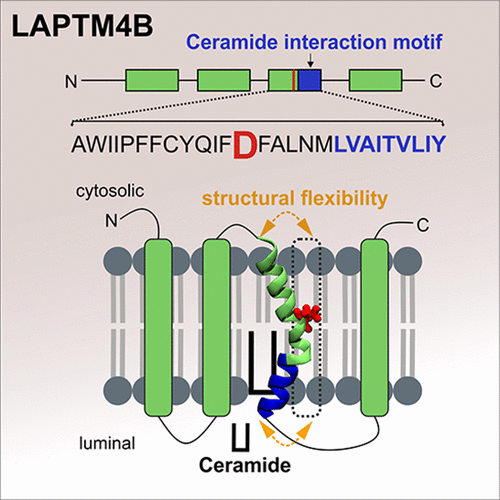当前位置:
X-MOL 学术
›
ACS Cent. Sci.
›
论文详情
Our official English website, www.x-mol.net, welcomes your
feedback! (Note: you will need to create a separate account there.)
A Ceramide-Regulated Element in the Late Endosomal Protein LAPTM4B Controls Amino Acid Transporter Interaction
ACS Central Science ( IF 12.7 ) Pub Date : 2018-05-09 00:00:00 , DOI: 10.1021/acscentsci.7b00582 Kecheng Zhou 1, 2 , Andrea Dichlberger 1, 2 , Hector Martinez-Seara 3, 4 , Thomas K. M. Nyholm 5 , Shiqian Li 1, 2 , Young Ah Kim 6 , Ilpo Vattulainen 4, 7 , Elina Ikonen 1, 2 , Tomas Blom 1, 2
ACS Central Science ( IF 12.7 ) Pub Date : 2018-05-09 00:00:00 , DOI: 10.1021/acscentsci.7b00582 Kecheng Zhou 1, 2 , Andrea Dichlberger 1, 2 , Hector Martinez-Seara 3, 4 , Thomas K. M. Nyholm 5 , Shiqian Li 1, 2 , Young Ah Kim 6 , Ilpo Vattulainen 4, 7 , Elina Ikonen 1, 2 , Tomas Blom 1, 2
Affiliation

|
Membrane proteins are functionally regulated by the composition of the surrounding lipid bilayer. The late endosomal compartment is a central site for the generation of ceramide, a bioactive sphingolipid, which regulates responses to cell stress. The molecular interactions between ceramide and late endosomal transmembrane proteins are unknown. Here, we uncover in atomistic detail the ceramide interaction of Lysosome Associated Protein Transmembrane 4B (LAPTM4B), implicated in ceramide-dependent cell death and autophagy, and its functional relevance in lysosomal nutrient signaling. The ceramide-mediated regulation of LAPTM4B depends on a sphingolipid interaction motif and an adjacent aspartate residue in the protein’s third transmembrane (TM3) helix. The interaction motif provides the preferred contact points for ceramide while the neighboring membrane-embedded acidic residue confers flexibility that is subject to ceramide-induced conformational changes, reducing TM3 bending. This facilitates the interaction between LAPTM4B and the amino acid transporter heavy chain 4F2hc, thereby controlling mTORC signaling. These findings provide mechanistic insights into how transmembrane proteins sense and respond to ceramide.
中文翻译:

晚期内体蛋白LAPTM4B中的神经酰胺调节元件控制氨基酸转运蛋白的相互作用。
膜蛋白在功能上受周围脂双层的组成调节。内体晚期区室是神经酰胺(一种生物活性鞘脂)生成的中心部位,神经酰胺可调节对细胞应激的反应。神经酰胺和晚期内体跨膜蛋白之间的分子相互作用是未知的。在这里,我们在原子细节上揭示了与神经酰胺依赖性细胞死亡和自噬有关的溶酶体相关蛋白跨膜4B(LAPTM4B)的神经酰胺相互作用,及其在溶酶体营养信号传导中的功能相关性。神经酰胺介导的LAPTM4B调节取决于鞘脂相互作用基序和该蛋白的第三个跨膜(TM3)螺旋中相邻的天冬氨酸残基。相互作用基序为神经酰胺提供了优选的接触点,而相邻的膜嵌入酸性残基赋予了柔韧性,该柔韧性受到神经酰胺诱导的构象变化的影响,从而减少了TM3的弯曲。这促进了LAPTM4B和氨基酸转运蛋白重链4F2hc之间的相互作用,从而控制了mTORC信号传导。这些发现为跨膜蛋白如何感测和响应神经酰胺提供了机械方面的见解。
更新日期:2018-05-09
中文翻译:

晚期内体蛋白LAPTM4B中的神经酰胺调节元件控制氨基酸转运蛋白的相互作用。
膜蛋白在功能上受周围脂双层的组成调节。内体晚期区室是神经酰胺(一种生物活性鞘脂)生成的中心部位,神经酰胺可调节对细胞应激的反应。神经酰胺和晚期内体跨膜蛋白之间的分子相互作用是未知的。在这里,我们在原子细节上揭示了与神经酰胺依赖性细胞死亡和自噬有关的溶酶体相关蛋白跨膜4B(LAPTM4B)的神经酰胺相互作用,及其在溶酶体营养信号传导中的功能相关性。神经酰胺介导的LAPTM4B调节取决于鞘脂相互作用基序和该蛋白的第三个跨膜(TM3)螺旋中相邻的天冬氨酸残基。相互作用基序为神经酰胺提供了优选的接触点,而相邻的膜嵌入酸性残基赋予了柔韧性,该柔韧性受到神经酰胺诱导的构象变化的影响,从而减少了TM3的弯曲。这促进了LAPTM4B和氨基酸转运蛋白重链4F2hc之间的相互作用,从而控制了mTORC信号传导。这些发现为跨膜蛋白如何感测和响应神经酰胺提供了机械方面的见解。











































 京公网安备 11010802027423号
京公网安备 11010802027423号